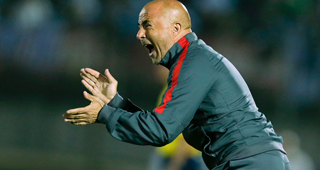“It’s a boost for us to see how excited he is”, said Argentine manager Jorge Sampaoli about Lionel Messi when taking over the national side last June. One year and four CONMEBOL qualifying matches later, Argentina continue to over-rely on the Barcelona striker to piece together what on the surface looks like an unbalanced 23 player World Cup roster focused on players operating through the central midfield. While the Messi equation is tested and true with Argentina making the finals of their last three international tournaments, he is 30 years old this time around. Sampaoli was hired to relieve Messi’s playmaking burden to the rest of the lineup through his unique vision of off-ball pressure and uptempo, direct passing that led Chile to their first ever senior international title at the 2015 Copa America.
The 58-year-old manager left Sevilla after leading the Spanish side to their second highest point total in club history to take over an Argentina position he described as “a dream.” There was no honeymoon period with Argentina battling to qualify out of a difficult and vaunted South American region. His side drew three matches and won one since he took over, finishing third in the group. Yet in what should have been a period of tactical development and honing player chemistry, their cancellation of a friendly match against Israel in the week leading up to the World Cup added an off field distraction in addition to the pressure of an entire country’s expectations (Sampaoli described the tournament as a “revolver to the head”. On the field, the cancellation left just a 4-1 win over Haiti, in which Messi scored a hat trick, as Argentina’s only warm-up match before the start of the tournament.
The lack of match preparation is significant as Sampaoli attempts to implement a paradigm shift in energy and pressing on an aging front line featuring the usual suspects Gonzalo Higuain and Sergio Aguero alongside Paulo Dybala. A rumored 2-3-3-2 formation would be the most idiosyncratic and risky in a tournament filled with familiar 4-2-3-1 or 4-3-3 shapes where managers can plug and play pieces on short notice. If his Chile teams were full of athleticism and energy, this Argentine side feels like a denouement of a generation of attackers playing in their last major tournament. As Jonathan Wilson writes, the irony of Sampaoli’s current situation is that while he is currently the best Argentine coach in the world, his style requires quick defenders who play up the field as opposed to the old, veteran players on his world cup roster.
Regardless, for 2018, how far Argentina goes in this tournament depends on Messi’s creativity. And even that hasn’t been enough, as one could distill Argentina’s losses in tournament finals to a lack of one incisive finish at the right moment. There are add nuances this time around, such as rumored chemistry between the 22-year-old Cristian Pavon and Messi, with Barcelona now linked with the Boca Juniors forward in the transfer market. And while Pavon isn’t the name of Higuain or Aguero, that sort of partnership has eluded Messi on the international stage. The whole has yet to live up to the individual parts.
But this is the problem Sampaoli dreamed of solving, as he wanted to generate “something important for Argentine football.” The overriding theme of Argentina in 2018 appears simple: put Messi in a position to win matches. And regardless, Sampaoli’s contract runs through 2022 and one more World Cup run. Argentina FA president Claudio Tapia insisted that Sampaoli would return as manager even if his side fail get out of the group stages. We know he can transform a side when starting from scratch, as he did with integrating a new generation at Chile and a new roster at Sevilla. With that job security in mind, Sampaoli is playing with house money in Russia. His true impact over the national team will be shaped over the following years heading into 2022.



